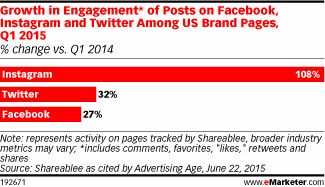Earlier this week, we posted a story on how Instagram is set to make a fortune on display ads, with an estimated $595 million for this year alone, rising up to $2.81 billion in the next couple of years. However, a new report from eMarketer digs a little deeper into this story, regarding how there’s major engagement between both paid ads and organic marketing.
According to eMarketer‘s numbers, brand engagement on Instagram has easily expanded over other social networks, with Instagram increasing by 108 percent compared to Twitter (32 percent) and Facebook (27 percent). And on the organic side of things, Instagram users have the ability to see every post from their accounts, depending on how often they log in. As a result, there’s instantly higher engagement, instead of hit-and-miss ads that appear in news feeds, and can easily be scrolled past.

One example of this engagement is retailer Dot & Bo, who has both Facebook and Instagram accounts. Allyson Campa, the company’s vice president of marketing, explained that it has a similar number of “likes” across both pages — although it has under 9,000 followers on Instagram and over 620,000 on Facebook.
They aren’t the only success story. A Mini USA spokesperson also reported that more than 20 percent of its followers typically see posts through its account, at a higher rate than on Facebook.
Ad engagement has also seen an increase on Instagram, as the company noted that advertisers in Canada have seen a brand lift from 14 to 45 points — not too shabby.
“if you think about ad recall on the platform, it’s nearly three times what you would see across the industry, generally speaking,” said Jim Square, Instagram’s director of market operations.
Now it’s just a matter of seeing if Instagram can live up to its prediction numbers. This will mainly come with ad rollout, as well as pitches that come from marketers. So far, the company appears to be taking it slow, so that it doesn’t irritate users with a flood of advertisements, instead going for a more organic approach.
We’ll see how it pays off over the next few months.

